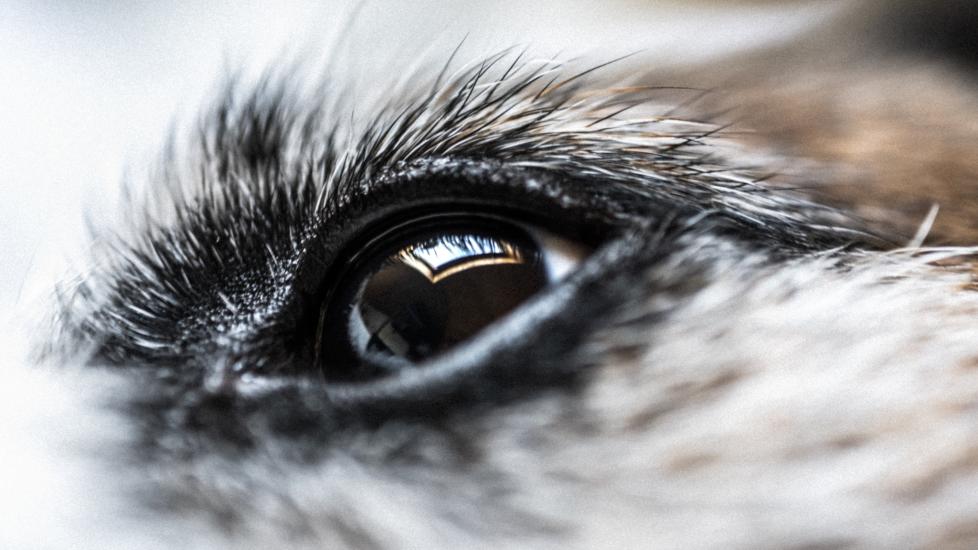Distichiasis in Dogs
cirano83/iStock / Getty Images Plus via Getty Images
What Is Distichiasis in Dogs?
Distichiasis in dogs is one of several conditions in which a dog has abnormal eyelash growth.
In this case, the eyelash grows out of the opening of a meibomian gland on the eyelid margin rather than growing out of the regular lash line. The meibomian glands are along the inside margin of the eyelid and produce part of the eye’s tear film. When a hair grows out of the gland, the hair can rub on the cornea (clear outer layer of the eyeball), causing irritation.
One eyelash growing out of the meibomian gland is called a distichia (plural is distichiae). Usually, there are multiple distichiae and both eyes are usually affected. Most dogs with distichiasis develop the condition at a young age, often before turning 1 year old.
If you look closely, you can usually see the abnormal eyelashes lying against the cornea. Some dogs may have thicker lashes that can be seen from a distance, while others may have just a few thin hairs that have to been viewed up-close to notice. If the eyelashes are soft, they may not bother your dog.
In some cases, course or stubby eyelashes can cause a lot of irritation to the eyes as they poke at the corneas. Other similar eyelash conditions that cause irritation to the cornea are ectopic cilia or trichiasis. An ectopic cilium is an eyelash that grows through the inside of the eyelid toward the cornea rather than coming out of a gland opening. Trichiasis occurs when hairs from a normal location are directed at the cornea, such as a normal eyelash that curls in or long hairs from the muzzle that poke the eye.
Distichiasis is a common condition in dogs, so it should be considered if your dog has chronically irritated eyes.
Symptoms of Distichiasis in Dogs
Symptoms of distichiasis in dogs include:
-
Eyelashes from the eyelid margin lying across the cornea
-
Excessive blinking, squinting, or difficulty keeping the eye open
-
Pawing at the eye
Causes of Distichiasis in Dogs
Distichiasis occurs due to chronic inflammation within the meibomian glands. Development of distichiae can be spontaneous but it is also likely to have a genetic component.
Breeds predisposed to distichiasis include:
How Veterinarians Diagnose Distichiasis in Dogs
Veterinarians can usually diagnose distichiasis with a physical exam alone. However, if your veterinarian suspects other eyelid abnormalities or is having trouble examining the eyelid margin due to your pet’s behavior or excessive blinking, sedation may be needed.
If your veterinarian suspects an ulcer on the eye, they may apply a special stain called fluorescein and look at the eye with a blue light to see if there is an injury to the cornea.
Your veterinarian might also place a numbing eyedrop into the eye to make examination easier and provide temporary relief for your dog.
Treatment of Distichiasis in Dogs
If distichiasis isn’t causing any irritation for your dog, then treatment isn’t necessary. With mild cases, the veterinarian may recommend a lubricating gel or ointment to help reduce irritation.
They may also try plucking the abnormal hairs to see if the irritation resolves. This would usually require sedation. If the irritation goes away after plucking and recurs with hair regrowth, then the corneal irritation is due to the distichiae.
Hairs will usually regrow within four to six weeks. Keep in mind that eyelash growth may be stubbier, so that new growth may increase the risk of corneal abrasion or ulcers.
For more permanent removal, your veterinarian will recommend cryotherapy (freezing the affected area), electrolysis (using an electric current to kill the hair follicle), or surgical removal. These procedures are done under general anesthesia.
Surgical removal is an option only if there are only a few offending lashes in a small area. Surgery carries the risk of causing eyelid deformity. Both electrolysis and cryotherapy may require more than one session to address all distichiae.
Recovery and Management of Distichiasis in Dogs
If your dog doesn’t need surgery at this time, watch for signs that could indicate the eyelash has started bothering them, such as discharge from the eye or squinting.
After any procedure involving the eye, it’s important that you prevent your pet from either scratching their eye or rubbing it on surfaces. A recovery cone should be worn for at least seven to 10 days.
Unfortunately, doughnut-type e-collars may not work well for your dog recovering from an eye procedure, as they can still rub their eye on the floor or furniture. You’ll want to select a recovery collar that is cone-shaped and follow your veterinarian’s recommendations for how long to keep it on.
Your veterinarian may also prescribe antibiotic and/or anti-inflammatory eyedrops to prevent infection or reduce pain after the procedure.
Once the hairs have been permanently removed, your dog has a good prognosis.
Prevention of Distichiasis in Dogs
You cannot prevent your dog from getting distichiasis, but it’s recommended to avoid breeding dogs with distichiasis to reduce incidence in future generations.
